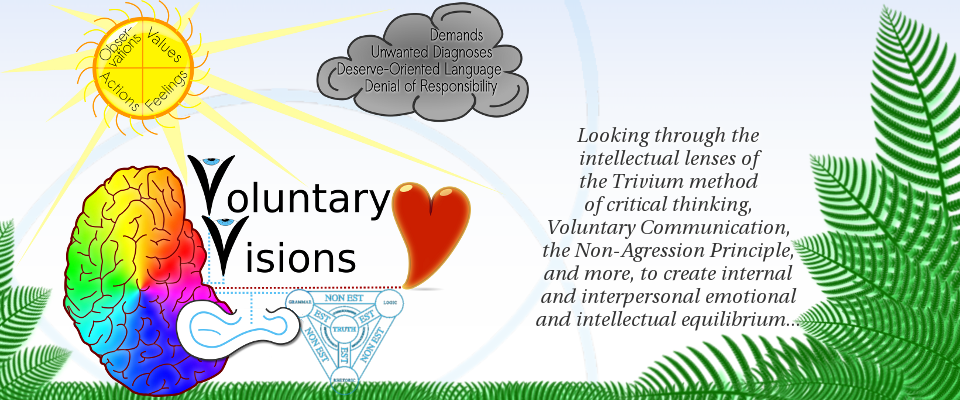
253: The Trivium Method Applied – Voluntary Communication (Part 4 of 4, Advanced Strategies and Review)
Part Four: Advanced Strategies and Review
What are the results of knowing and using the skills of the Trivium Method of critical thinking in conjunction with the skills of using Voluntary Communication, also known as Non-Violent Communication (or NVC)?
This show concludes a series about Merging the Trivium Method with Voluntary Communication or NVC, and developing strategies for better interpersonal connections. Darrell Becker will be co-hosting all episodes in this series.
Discussed Today: (Darrell’s Notes)
Statements and Phrases to Help Generate Connection
Here’s a strategy for designing greater empathetic and intellectual effectiveness (as defined above) in one’s own life:
1. Internal Intellectual Equilibrium & Internal Empathetic Equilibrium is desired, designed, engineered and created. “Splinters of the Mind” are self-identified and removed.
2. “Bridges of Empathy” are desired, designed, engineered and created.
3. Connection between individuals is established, logical and empathetic communications are established. Assessments of evidence begins to be made with greater depth and scope, and conclusions are drawn and redrawn using the evidence of intellectually and empathetically acquired data. Obstacles are identified.
4. Creativity is allowed to occur, which is encouraged by enhanced Flexibility with each individual’s intellectual and empathetic methods.
5. Innovation occurs, and the obstacles are seen as opportunities, by creating artistic expressions, businesses providing goods and services which help to remove the effects of the obstacles (or remove the obstacle completely), social events, and creative applications that are as-yet unknown.
Proper Care of One’s Lenses: Questions to ask and answer for one’s self:
1. Are my lenses scratched or splattered with obstructing images, such as appeals to any authority wherein the evidence is referred to but there is not any primary or secondary corroboration of the supporting evidence?
2. What observations (available from your favorite search engines on the internet) are available covering various pro/con/objective/subjective/alternative perspectives involving whichever type of “lens” that is being considered (i.e. NVC, the Trivium method, etc)?
3. How does the use of the methods of the above-described “lenses” work in terms of analysis using this version of the “Maslow’s Hierarchy of Needs”?
Phrases and Expressions that are potentially useful for “Building Bridges of Empathy”
1. “Perhaps….What do you think of this assertion/observation?”
2. “Would you be willing to hear me out on this idea or observation?” (It might often be preferable for there to be made explicitly clear that there is an “opt out” function for them to say “No!” and for more options to be included in the discussion.)
3. (To say quietly to one’s self, usually…) “I noticed when I observed _____ I felt ____ because of some apparent desire or value I had for _____ . I’ll make a plan to say/do ____ now, or later on, so as to fulfill my own personal desire or value for ______.” All of this is done quietly in one’s own head, unless this is being shared with someone who both knows and understands these skills, as well as has the empathetic equilibrium and interest in one’s own emotional and intellectual landscape.
4. “I wonder if ______. What do you think about this idea/observation?”
5. “I speculate that _____. Perhaps ________? What do you think?”
6. “It seems possible to me that ______. Does it seem to you that _______?”
7. “Would you be willing to summarize your conclusions? I might need help with understanding your assertions, and I’m willing to try again to better understand what you are asserting.” [Conclusions, assertions and “beliefs” are identified, for the purpose of clarity in communication.]
8. “What is it that you personally advocate for? What is it that you personally would suggest, regarding our discussion?” [Suggestions and advocacies are identified for the purpose of clarity in communication.]
9. [This is a conceptual strategy.] “Insults” are viewed as being words or actions that might be interpreted as hostile acts or “Attacks”. As with all “Attacks”, a “Target” is required to make the “Attack” appear to have any effect in any real way. The “Target” could be real things (people, items, etc.) or abstract things (ideas, ideologies, “beliefs”). If the “Target” is a person or a tangible and measurable aspect of reality, the “Attack” can be analyzed as potentially being against real people or items. If the “Target” is an idea, a person is required to identify with the idea in such a way as to feel the impact of the “Attack” in order for the words to create any seeming effect.
One of the key words is “interpreted”: it is within the practical (meaning that it is explainable and yields desired and predictable results) knowledge and understanding of the interpretation of words that a person can choose to “Receive” the insult, or to offer “thanks, but no thanks this time” regarding the decision to decline to take the “Gift” of the words, but to gently acknowledge the generosity of the “Gift” that was offered. There is the opportunity to take the (alleged)“Insult” as being connected to describing the feelings and motivating factors of the person who is “Offering” the “Insult”.
Words with great potential for “Definition Wobble” – Potential Problems with Mutual Identification
1. Forgive- (often implying a desire for increased understanding, respect, connection and caring).
2. Apology- (a communication attempting to implying a desire for increased understanding, respect, connection and caring).
Look Closer:
Lesson 28: Elf on the Shelf — Innocent Holiday Whimsy or Dangerous Informant? – http://thestir.cafemom.com/big_kid/130507/lesson_28_elf_on_the/
Voluntary Visions – Darrel’s Blog – http://voluntaryvisions.blogspot.com/
Darrell’s Communication Glossary – http://schoolsucksproject.com/practical-definitions-voluntary-communication-by-darrell-becker/
Center for Nonviolent Communication – https://www.cnvc.org/
Jan Irvin’s Site, Trivium Education – http://www.triviumeducation.com/
T&H Trivium Resources – https://www.tragedyandhope.com/trivium/
Discouraging words: Life-alienating communication – http://www.noogenesis.com/malama/discouragement/words.html

